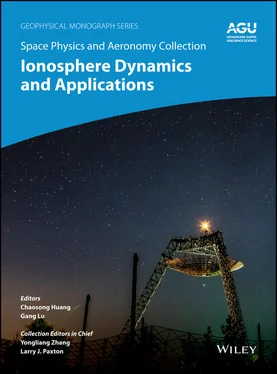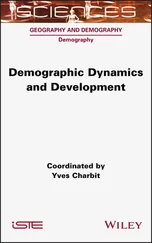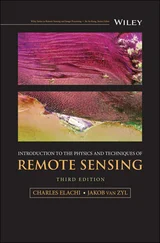Discrepancies also appear when comparisons of neutral density and model predictions are carried out (Shim et al., 2012). Storm‐related neutral density perturbations have been observed poleward of the auroral zone in several event and statistical studies (Lühr et al., 2004; Liu et al., 2010; Huang et al., 2014, 2016).
1.6 FUTURE DIRECTIONS
1.6.1 New Data Analysis and Modeling Approaches
Capturing the energy input to the IT system is crucial to realistic specification and forecast of the IT response to solar wind driving. An assessment of the ability to forecast the impact of space weather on Total Electron Content and neutral density shows significant gaps in current capabilities (Shim et al., 2015). While large‐scale averages over several hours or large geographic areas generally indicates approximate agreement between model and observed parameters, comparisons on finer scales show discrepancies, which can be large, as indicated in the Rastaetter et al. (2016) study. Current operational models of MIT coupling depend on empirical and climatological approaches, which have limited forecast capability. The outstanding problem, illustrated in the model assessment carried out by Rastaetter et al. (2016), is that there is little consistency in the apparent model discrepancies. The discrepancy varies from event to event and from model to model.
There are two classes of potential errors in the models:
1 The current trend in GCMs is to use empirical models for the high‐latitude drivers. As has been pointed out, the results of these simulations can reproduce the average state of the ionosphere, but when detailed data for specific locations under specific conditions are compared with model predictions, the models show poor agreement.
2 In the GCMs, a number of assumptions are made in order to reduce computational demands. The assumptions are reasonable if the system is driven by large‐scale perturbations in the solar wind. But the effect of small‐scale variability can be large as we discuss below.
There are a number of possible solutions, which might alleviate the problem. Data assimilation has been used in the AMIE model, but as noted above, there are restrictions on the application of the methodology. Other assimilative models and tools such as the Data Assimilation Research Testbed (Anderson et al., 2009), the Global Assimilation of Ionospheric Measurements (USU_GAIM), the Global Assimilative Ionospheric Model (JPL‐GAIM), the Ionospheric Data Assimilation Four‐Dimensional (IDA4D) model, and others (Schunk, 2002; Scherliess et al., 2004; Hajj et al., 2004; Pi et al, 2004; Bust et al, 2004) have been developed but not widely applied to the high‐latitude region. The complexity of assimilation at polar latitudes is twofold. When energy enters high latitudes, it is typically sporadic and dynamic; hence, fluctuations on small temporal and spatial scales can be significant. Second, data in the Northern Hemisphere are sparse due to the high percentage of ocean. Distribution of ground receivers is limited and coverage is irregular. In the Southern Hemisphere, distribution of ground instruments is limited by harsh climatic conditions.
Expansion of radar coverage by Super Dual Auroral Radar Network (SuperDARN), European Incoherent Scatter Scientific Association (EISCAT), and Resolute Bay Incoherent Scatter Radars (ISRs) in the NH polar cap provides data at high latitudes not previously available. Networked arrays such as AMPERE and SuperMAG also extend coverage in space and/or time. Data analysis has historically relied on event analysis or statistical analysis of selected events, but new methodologies based on machine learning in analysis of distributed data may provide added insight into the physical process. Examples of network analysis applied to the SuperMAG array are shown by Dods et al. (2015, 2017). The approach treats the correlated data between each pair of stations in order to estimate the connectivity of the substorm response across the network. The method leads to characterization of substorms in terms of spatial extent and level of cross correlation. The connectivity can also be used to characterize amplitude, phase, and direction of the substorm activity. The number of ground stations used in the analysis was around 100. Applying the methodology to response of the FACs to changes in IMF during quiet, nonstorm intervals, Dods et al. (2017) found a network response of 8–10 minutes, and impact at dayside stations occurred 2–8 minutes before nightside. The methodology is currently limited by the need for relatively dense networks, which now restricts wider application, but further investigation into this new approach would help to determine how best to utilize this new technique.
The highest density of ionospheric data sources is probably the Global Navigation Satellite System (GNSS), a worldwide array of GNSS receivers. Data from approximately 5,000 receivers is newly available through the CEDAR Madrigal website ( http://cedar.openmadrigal.org/index.html/). The repository contains vertical TEC for the past 20 years, and slant TEC for the past 2 years at the time of writing. It is expected that this will increase with time. While coverage at polar latitudes is restricted as noted above, GNSS data complements existing radar facilities and polar‐orbit satellite data collection. GNSS data are the basis of certain assimilative models as mentioned above. Wider distribution of TEC data will contribute to more accurate specification via assimilation, but does not resolve the outstanding problem of forecasting the IT response when the solar wind is fluctuating.
A question related to data coverage and analysis is the relevant resolution required to capture the IT system response to magnetospheric input. It has been shown that estimates of Poynting flux increase if higher resolution data are used to capture the variability in the electric field (Codrescu et al., 1995; Cosgrove & Codrescu, 2009; Matsuo & Richmond, 2008). However, there has not been an investigation into the geoeffectiveness of the variability that should be carried out in order to place limits on required resolution for data as well as models. While it seems intuitive that larger Poynting flux will result in larger Joule heating, it is not clear whether the IT response depends on other constraints, such as the time needed for collisional chemical reactions or for transfer from Poynting flux power into kinetic energy of ions or neutrals.
The field of MIT coupling has been dominated by fluid theory for many years, but as computer power has increased, ideas based on kinetic theory have been developed. Wave power is often ignored as a source of high‐latitude energy, but observations have shown that Alfvén waves, commonly present in the interplanetary medium, can contribute to the total energy available (Tsurutani et al., 1990, 1995; Chaston et al., 2005; Streltsov & Lotko, 2003; Verkhoglyadova et al., 2018). Kinetic transport of super‐thermal electrons (Khazanov et al., 2014, and references therein) show significant energy deposition related to magnetosphere‐ionosphere coupling processes. Evidence of ULF waves reaching ground observatories at polar latitudes has been reported for some time (Wolfe et al., 1996; Papitashvili et al., 1996). Connection from the southern pole to the magnetosphere is still debated (Urban et al., 2016). Inclusion of kinetic processes within MHD or GCM codes is still in its infancy, although initial results are intriguing (Chen et al., 2017; Tóth et al., 2017). Many of these ideas have yet to be included in models of IT energy input and compared with observations.
1.7 SUMMARY AND CONCLUSIONS
Entry of energy in the IT system has been studied at length by analysis of observations and by development of a comprehensive suite of models. Overall, the deposition and dissipation of energy can be represented fairly well if climatological results or large‐scale averages in space and time are required. If more accurate specification and forecast of the IT response is required, the problem of energy input and dissipation needs to be reinvestigated. Currently, the auroral zones are the only high‐latitude region for which energy deposition is captured, and only under relatively steady conditions. At polar and subauroral latitudes, where energy input can be sporadic, the empirical models based on smoothed averages do not specify energy well.
Читать дальше












